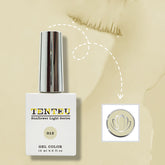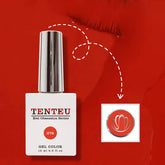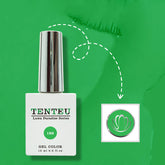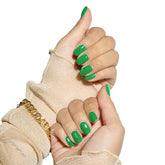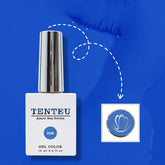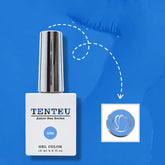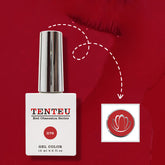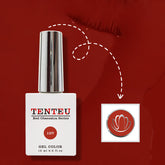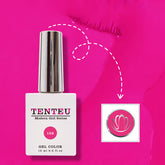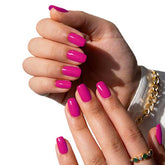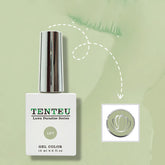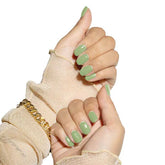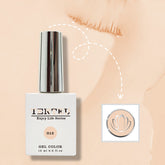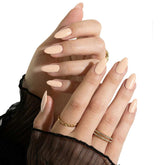Pedido mínimo $30, envío gratis a partir de $99


Nail Stamp
- $1.80
- $1.80
- Unit price
- per
SKU:
92030
Availability:
In Stock
Please hurry! Only 9 left in stock
Ofertas por tiempo limitado, terminan en:
151D
8H
23M
0S
10 customers are viewing this product
Couldn't load pickup availability
Free Shipping
Free standard shipping on orders over $99
Free Returns
Learn More.
Built And Shipped Within 7 - 10 Bussiness Days
Application
A nail stamp is a tool used to quickly and accurately print various patterns and designs on nails. It can help nail art enthusiasts and professional nail artists create complex and diverse nail effects, saving time and improving efficiency. The following is an introduction to the main uses of nail stamps:
- Fast pattern transfer
Nail stamps can quickly transfer pre-designed patterns from templates to nails. This eliminates the need for users to draw complex patterns by hand, greatly saving time and energy. - Diverse design options
Nail stamps are often used with various templates that have a variety of patterns on them, such as flowers, geometric figures, animal patterns, etc. Users can choose different templates according to their preferences and needs to create a variety of nail designs. - Detailed and precise patterns
By using nail stamps, very fine and complex patterns can be easily achieved, which is an effect that is difficult to achieve by hand. Stamps can ensure that the pattern is accurate every time, which is suitable for nail art designs that require high details. - Enhance creativity and innovation
Nail stamps allow users to try various innovative nail styles and combinations. For example, different colors and patterns can be superimposed on each other to create a unique, personalized nail art effect. - Uniform and consistent effect
Using nail art stamps can ensure that the pattern on each nail is consistent, avoiding the unevenness and errors that may occur when hand-painting. This is especially important for nail art designs that require a unified style. - Suitable for novices and professionals
Nail art stamps are easy to operate and suitable for beginners, while also meeting the needs of professional manicurists for complex designs. It makes it easy for anyone to get started and quickly master the production skills of various nail art patterns. - Special occasions and themed nail art
By using different stamp templates, nail art enthusiasts can design corresponding nail art styles according to festivals, celebrations or specific themes (such as weddings and parties). For example, snowflakes or Christmas tree patterns can be used for Christmas, and pumpkins or ghost patterns can be used for Halloween. - Personalized customization
Nail art stamps also allow users to design and create their own templates to achieve completely personalized nail art patterns. This customization ability allows users to perfectly reflect their creativity and personal style on their nails.
Advantage
- Easy to operate
Nail art stamps are very simple to use, and even novices can quickly get started. Just apply nail polish on the template, scrape off the excess nail polish with a scraper, and then use the stamp to pick up the pattern and transfer it to the nail. This simple and intuitive operation method makes it easy for anyone to create exquisite nail art patterns. - Efficient and time-saving
Compared with hand-painted nail art, nail art stamps can complete complex pattern designs in a short time. The stamp tool can quickly and accurately transfer the pattern to the nail, greatly reducing the time cost of nail art, which is especially suitable for occasions where nail art needs to be completed quickly or busy manicurists. - Diverse patterns
Nail art stamps are usually equipped with a variety of templates, each with different patterns, such as flowers, animals, geometric figures, etc. These templates can provide a rich and diverse selection of nail art designs to meet the needs of various styles and themes. Users can change the templates at will according to their preferences and creativity to create unique nail art effects. - Fine patterns
Nail art stamps can achieve very detailed and complex patterns, which are often difficult to achieve by hand-painting. Stamp tools can accurately transfer fine lines and graphics, ensuring that each pattern is clear and beautiful. This is a great advantage for nail art designs that pursue details and perfection. - Strong consistency
Using nail art stamps can ensure that the pattern on each nail is consistent, and there will be no unevenness or errors due to differences in hand painting. For nail art designs that require a unified style, stamps can provide highly consistent results, ensuring that each nail art reaches the ideal standard.
How to use
Using nail art stamps, you can easily achieve beautiful nail art designs. Here is the general process of using nail art stamps:
- Prepare tools and materials:
Nail art stamp set: including stamps, templates and scrapers, etc.
Nail polish: Choose nail polish of your favorite color or pattern. - Prepare nails:
Clean nails: Make sure your nails are clean and grease-free, and use nail polish to remove old oil and dirt on your nails.
Trimming and tidying nails: Trim the length of nails according to personal needs and arrange the shape of nails. - Apply base color:
Use transparent base color: In order to protect your nails and make the nail polish more durable, apply a layer of transparent base color and wait for it to dry. - Apply nail polish:
Choose a pattern: Choose a pattern in the template according to your preferences.
Apply nail polish: Apply the desired nail polish color to the corresponding pattern position. Be careful to apply it evenly and not too thick. - Scrape off excess nail polish:
Quickly and gently use the scraper to scrape off the excess nail polish on the template. This will only leave the nail polish on the pattern part. - Transfer with stamp:
Quickly press the stamp gently on the pattern part on the template, and let the stamp absorb the nail polish.
Immediately transfer the pattern of the stamp to the nail, press gently for a few seconds to ensure that the pattern is completely transferred to the nail. - Cleaning and correction:
Clean the stamp and template in time: wipe the nail polish on the stamp and template with a cotton swab or paper towel to prevent cross-contamination of colors. - Correction of mistakes: If there is an accidental smearing or transfer error, you can use a cotton swab to dip the nail polish to remove the wrong part.
- Finish the coating:
Wait for drying: Wait for the transferred nail polish to dry. You can use quick-drying nail polish or use a fan to speed up the drying process.
Apply a layer of clear top coat: To protect the nails and make the manicure last longer, apply a layer of clear top coat.
Precautions
- Choose quality tools:
Use high-quality stamps and templates to ensure the clarity and transfer effect of the pattern.
Avoid using low-quality nail polish, as they may dry too quickly and affect the transfer effect. - Keep the tools clean:
Clean the stamps and templates immediately after each use to prevent nail polish residue from affecting the next use.
You can use a special cleaner or ordinary nail polish remover to clean the tools. - Quick operation:
The transfer process needs to be done quickly because nail polish dries quickly. It is recommended to keep consistency and speed between the actions of applying nail polish, scraping off excess oil, and pressing the stamp on the template. - Appropriate pressure:
When using the stamp, do not apply too much pressure to avoid deformation of the pattern. Just press gently.
Make sure the stamp fully contacts the pattern area of the template to obtain a complete pattern. - Nail preparation:
Ensure that the nail surface is clean, smooth, and free of grease or dirt, which can improve the adhesion and durability of the pattern.
If there is an uneven nail surface, you can first use a sanding block to smooth it out, and then apply a primer for protection. - Color selection:
Choose a contrasting color for transfer, such as light-colored nail polish with a dark pattern, so that the pattern will be clearer and more prominent. - Avoid too thick a coating:
When applying nail polish, do not apply it too thickly, a thin layer of nail polish will be enough, so that the transferred pattern will be more delicate and clear. - Correcting errors:
If an error occurs during transfer, you can use a cotton swab to dip a small amount of nail polish remover to gently wipe off the wrong part, and then re-transfer. - Protective coating:
After completing all the steps, it is recommended to apply a layer of transparent top protective paint to make the pattern more durable and increase the gloss.
Make sure the top paint is completely dry to avoid collision or friction to damage the pattern. - Ambient temperature and humidity:
The temperature and humidity of the operating environment will affect the drying speed of the nail polish. It is recommended to operate in a warm and dry environment.
If the ambient humidity is high, a fan or a hair dryer (low temperature) can be used to accelerate the drying of the nail polish.
Related Products
Recently Viewed Products
- Choosing a selection results in a full page refresh.
